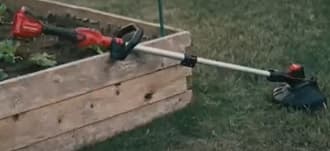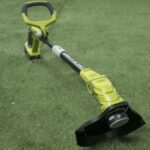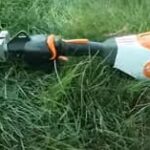As an Amazon Associate, this site earns commissions from qualifying purchases. For more information click here.
Is your weed eater always getting stuck in the overgrowth? Are the cuts and trims not as smooth and efficient as before? Those are clear signs you need to replace the string. This is nothing to worry about though, as I will show how easy it is. String trimmers use the same mechanism so these steps will work regardless of your brand.
The basic steps for replacing a weed eater string are:
- Press the tabs on the trimmer cap to pull the spool and string out.
- Cut the new string to the desired length.
- Put the new string in the spool and put the cap back on.
Note: string, line and wire are used interchangeably, and that is how I use them in this guide.
If you are looking for quality weed eater strings, I recommend the Husqvarna string trimmer line. It is durable and easy to install.
As you can see it only takes a few steps to replace the string. If this is your first time to do this, the rest of this post covers the process in more detail.
You Will Need
- New weed eater string
- Cutting tool
If you would rather watch a video, this one shows you how it is done. It is with a Stihl but the method works with other brands.
Step 1: Take Off the Cap
To replace the string you need access to the spool. The spool is under the trimmer cap so you have to remove this first.
Turn the weed eater off and flip it over. If you have a Black and Decker 20V Max or any other cordless weed trimmer, remove the battery first. Unplug the cord if you use an electric weed eater.
Remove any screws you see with a screwdriver. If there are none, lift the cap off.
If the trimmer is old or you haven’t replaced the strings in a while, the cap can be hard to pull off. Put pressure or use a prying tool.
I want to add this though: some string trimmers let you pull the string out without having to remove the cap. If you own one of these, replacing strings is easier. Check the operating instructions that cam with your trimmer.
Step 2: Remove the Spool and String
Once you have removed the cap, you will see the disc inside the casing. Pull the spool and the string. This might require some force if the spool tightly fits in the casing.
Sometimes the string gets stuck and you will need to cut it off. Any cutting tool will do. Just remember which side of the spool faces out. This is going to make it easier to put it back in place. This process is the same for almost all trimmers.
Step 3: Take the Old String Off
This one is pretty straightforward. Undo the string, paying close attention to the last few inches and how it links to the spool.
Memorize how the string fastens to the spool because that is exactly how you are going to install the new string. Look for a hole in the spool where the string will go through.
If you can’t see a hole in the spool, look for a clip that sets the string in the middle of the spool. Once the string has been installed, you can add oil to the engine and start using it.
Step 4: Put the New String in the Spool
Hold the new string and put it in the spool. It has to be done the same way as the old string. When you remove the new string from the package, cut off about 25 feet and put it in the spool.
It doesn’t matter which end of the string you put in the spool. Based on my experience though, round strings are more durable than the plastic flat variants.
Whenever possible I use round strings. But some weed eaters only work with specific string types, so check what strings your trimmer can use.
I have also seen some string trimmers bundled with pre-wound spools. This allows you to replace the both the spool and string quickly. No need to unwind the string, just replace it. Not all trimmers provide this option though so you have to check with the manufacturer.
Step 5: How to Put the String in the Spool
Wrap the string along the spool. Make it as even as possible. The more even the string, the easier it gets to pull out.
Usually you roll the wire in a clockwise direction, but other spools have an arrow indicator so you’ll know which direction the string goes.
A few reminders when wrapping on the spool:
Wrap the string in a smooth, tight manner. Tighten any loose spots. Cut enough string so it fills just below the spool rim. Cut the excess string if it goes past the rim.
When the string is close to the spool rim, cut it so that only 5-6 inches remain. This is essential to get your weed trimmer working. Shears can cut the string but so can a good pair of scissors.
Firmly grab the spool and the weed eater. This makes it easy to put the cap and spool back. With other string trimmers, you have to close the tabs or press the spool until it locks.
Step 6: Reinstall the Spool in the Weed Eater
You are almost done. Put the spool in the weed eater casing. Pass the string into the opening. Turn the weed eater over and set the spool in the right position.
Place the opening in the spool center above the axle. Thread the string in the hole where the wire is sticking out and turns.
You have to position the spool exactly the same way as before. In most cases you can only arrange the spool one way so this won’t be a problem. If the spool has a logo, that is the part that needs to look away from the weed eater.
The last step is to put the cap back on spool casing. With some trimmers you have to latch tabs, put a screw on or press down.

Troubleshooting Weed Eater String Installation
My weed eater spool has an arrow on it. What does that mean?
The direction of the arrow is where you wind the string. The arrow is a very common symbol used by almost all major brands.
Why does the string always pull back into the spool? The string is brand new.
The string is too short. You have to put a longer string and leave 5-6 inches hanging out.
When should I replace a string trimmer line?
The rule of thumb is to replace the string at the beginning of each season. But if the string is broken or frayed, replace it right away. Strings wear out quicker when used on hard surfaces and thick weeds.
Should I wet a string before using it?
Yes. Soak the string in water for 24 hours and let it dry. Now you can install it on your weed eater. Some string trimmers may no longer require this so check your user manual.
Why is the string not coming out of the trimmer?
Check if you wound the string properly. A lot of times this happens because the string was not winded up correctly.
What is the right weed eater string size I should use?
Majority of weed eaters support 0.5 to .100 inches and above. For light yard work I recommend 0.50-.08 inches. If you have to do medium to heavy cutting, try .08-.105 inches. Anything higher than that is for really heavy duty trimming.
Thick strings last longer and cut faster. But it takes a lot more engine power to do it. Weed eaters have string size limits so keep that in mind.
How do I make a weed eater string last longer?
A lot of problems can be avoided by simply using the string as directed. Going back to string size for example. If you use the string to cut something more than it is capable of, it will wear out faster or break.

I love the outdoors and all the tools for maintaining gardens, yards and lawns. The only thing I am more passionate about is sharing what I know about garden and outdoor equipment.


